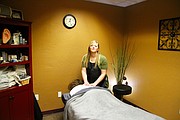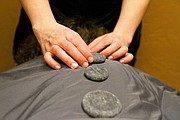All about deep tissue massage - ask the expert
The expert: Tysandra Gillis, a massage therapist of Hayden Health & Wellness.
Background: Gillis studied at the University of Western States out of Portland, Ore. She specializes in Swedish, deep tissue, sports, prenatal and hot stone massage, with continued education in aromatherapy and the muscle energy technique called SMRT - Spontaneous Muscle Release Technique.
Live Well asked Gillis to answer some questions about her work at Hayden Health & Wellness, as well as what people can do at home to ease discomfort in between treatments.
LIVE WELL: How does a deep tissue massage compare to a more traditional massage?
GILLIS: A deep tissue is a more focused massage, focusing on the deeper layers of the muscles and connective tissues, usually working on the chronically painful areas that a person is suffering from.
It is beneficial in releasing chronic muscle tension. A traditional massage, also
known as a Swedish massage, is used for a stress relief and relaxation.
LIVE WELL: What are some of the movements and methods one can expect in their session? Should people expect any pain or discomfort?
GILLIS: A massage therapist uses slow, deliberate strokes like myofascial release, cross fiber work, and friction that focus pressure on layers of muscles, tendons and other tissues. The therapist will use fingertips, knuckles, hands, elbows, and forearms during a deep tissue massage. The therapist will also ask you to use your breath to help ease through the tension areas.
As much as a massage therapist doesn’t want to tell their client, there may be certain times during a massage session when they may feel some discomfort in certain areas, especially as the massage therapist works on the areas where there are adhesions or scar tissue. But if you’re experiencing pain, be sure to tell your therapist and they can adjust their technique.
LIVE WELL: How does deep tissue massage compare in experience to physical therapy sessions or visiting a chiropractor?
GILLIS: A deep massage therapy is usually used for immediate relaxation of a person’s pain and muscle spasms, reducing the tissue tension and restoring the tissue/muscle to its resting length, whereas physical therapy and chiropractic work are geared more towards rehabilitating muscle and joint function and restoring their function.
LIVE WELL: How do you know if you are a good candidate for a deep tissue massage? What are some symptoms of specific pain that might indicate a need for one?
GILLIS: A deep tissue massage can be useful to those who are recovering from an injury, for athletes, for people with postural strains, or those with chronic pain. Typically there is an area, even a few areas, where this type of work is needed.
For example, a person who has chronic postural pain/tightness from sitting at a computer all day might need a deep tissue massage to their shoulders, chest, and upper back/neck. Pain, stiffness, slouching at work and even cramping are signs that you are in need of a deep tissue massage. Listen to your body. It will tell you and help you prevent injury and unnecessary pain.
LIVE WELL: How often can you get one? Do people see benefits after one
session or does it require more consistent intervention?
GILLIS: A client can feel immediate effects of a deep tissue massage, like headache
relief and ease of the tension. How often a person gets a deep tissue massage usually depends on the amount of stress someone holds in their body and the amount of pain that a person is in.
I typically recommended a deep tissue massage once a week for at least 4-6 weeks and then re-evaluate the problem areas. Then I recommend once a month for maintenance to prevent further injury.
LIVE WELL: Should you expect soreness after a deep tissue massage? What should people do after a session to maximize the intentions and minimize any discomfort?
GILLIS: After a deep tissue massage a person can feel immediate relief, but also after a day or two a client may feel sore, like after a workout, but it will always subside.
Using ice (this will reduce any inflammation and prevent pain and swelling) and drinking water
works best to alleviate the pain. Also, taking it easy and relaxing afterwards can maximize the benefits.
LIVE WELL: What are some exercises people can do from home in between massage sessions to ease their muscle discomfort?
GILLIS: I always recommend practicing yoga. Whether it is 10 minutes at your desk or a 30-minute session on a mat, yoga can go a long way to help improve your body’s tension points.
For example, stretching out your pectoral muscles through the front of your chest can help open up your shoulders. Using the stretch with exercising your rhomboid muscles to strengthen between your shoulder blades.
Also, be sure to schedule your next massage appointments before you get to a point where you desperately need one. It is more effective, and you and the therapist don’t have to start back over.
- • •
Hayden Health & Wellness provides several types of treatments, including massage, acupuncture, chiropractic care, nutritional counseling and much more. Visit www.HaydenHealth.com for more information on their services, or call (208) 635-5658. Office is located at 8827 N. Government Way in Hayden.









